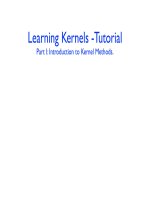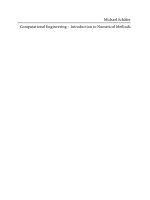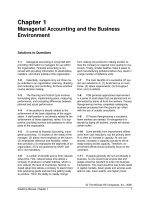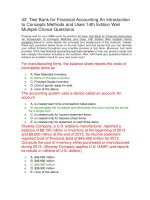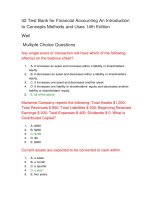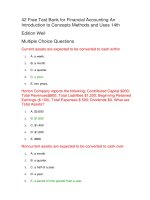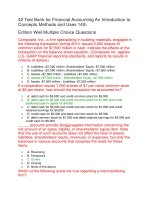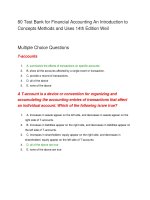Managerial accounting and introduction to concepts methods and user 11e by maher chapter 02
Bạn đang xem bản rút gọn của tài liệu. Xem và tải ngay bản đầy đủ của tài liệu tại đây (251.67 KB, 28 trang )
CHAPTER 2
Measuring
Product Costs
PowerPoint Presentation by
LuAnn Bean
Professor of Accounting
Florida Institute of Technology
© 2012 Cengage Learning. All Rights Reserved. May
not be copied, scanned, or duplicated, in whole or in
part, except for use as permitted in a license
distributed with a certain product or service or
otherwise on a password-protected website for
classroom use.
Managerial Accounting 11E
Maher/Stickney/Weil
1
☼
CHAPTER GOAL
☼
This chapter shows how the accounting system records
and reports the flow of costs in organizations to
answer questions such as these:
To determine product/service cost
To compare cost with management’s expectations
2
LO 1
DIRECT
DIRECT MATERIALS:
MATERIALS: Definition
Definition
Can be easily traced
directly to a product.
3
LO 1
DIRECT
DIRECT LABOR:
LABOR: Definition
Definition
Is labor of workers who
transform materials into a
finished product.
4
LO 1
MANUFACTURING
MANUFACTURING
OVERHEAD:
OVERHEAD: Definition
Definition
Includes all other costs of
transforming the materials
to a finished product.
5
LO 1
How are materials, labor not
directly traceable to a product
categorized?
All costs, including materials and
labor, not directly traceable to a
product are categorized as
Manufacturing Overhead.
6
LO 2
RESPONSIBILITY
RESPONSIBILITY CENTER:
CENTER:
Definition
Definition
Is any organizational unit
with its own manager or
managers.
7
LO 2
Responsibility
center
(department)
Records costs &
assigns to products
Direct
materials
Direct
labor
Overhead
Management compares
costs to standards
8
ACCOUNTING SYSTEM
PURPOSES
LO 3
1)
1) To
To record
record costs
costs by
by responsibility
responsibility for
for
performance
performance evaluation
evaluation and
and control.
control.
2)
2) To
To assign
assign manufacturing
manufacturing costs
costs to
to units
units
produced
produced for
for product
product costing.
costing.
9
LO 3
BASIC COST FLOW EQUATION
Beginning + Transfers = Transfers + Ending
Balance
In
Out
Balance
BB + TI = TO + EB*
*Recall from financial accounting:
Beginning Balance + Additions - Withdrawals = Ending Balance
10
COMPARING NORMAL and
ACTUAL COSTING
LO 4
Normal costing advantages
Smoothes seasonal and other fluctuations that
don’t relate directly to activity levels
More timely than actual because of estimating
process
11
LO 4
USING NORMAL COSTING
Select a cost driver (allocation base) to apply
overhead
Estimate dollar amount of overhead and level of
activity for period
Compute predetermined (normal) overhead rate
Apply overhead to production
12
LO 4
EXAMPLE
Plantimum Builders manually assembles small modular
homes. Using prior year data, Plantimum estimated
variable manufacturing overhead at $100,000, 50,000
direct labor hours, and $50,000 fixed manufacturing
overhead.
What is Plantimum’s variable overhead rate?
$100,000 / 50,000 dlh = $2.00 per direct labor hour
What is Plantimum’s fixed overhead rate?
$ 50,000 / 50,000 dlh = $1.00 per direct labor hour
13
LO 4
EXAMPLE
Actual direct labor hours for the month was 4,500.
How much variable overhead did Plantimum charge to
production for the month?
4,500 dlh X $2.00 per direct labor hour = $9,000
How much fixed overhead did Plantimum charge to
production for the month?
4,500 dlh X $1.00 per direct labor hour = $4,500
14
LO 5
COST SYSTEMS
An effective cost system must have
Decision focus: meets needs of decision makers
Different costs for different purposes
Variable costing for decision making
Full absorption for financial reporting
Cost-benefit test: benefits from cost system must
exceed its costs
15
LO 5
COST SYSTEMS: Examples
Job costing
For custom production jobs
Users: accounting and consulting firms, health care
organizations
Process costing
For standardized production
Users: drink makers (e.g., Coca Cola, etc.)
Operation costing
A hybrid of job and process combined
Users: Levi Strauss, Dell
16
LO 6
PLANTIMUM PRODUCTION
Plantimum produced 3 modular homes during the
month. Plantimum wonders whether they
should use job order costing or process
costing? What do you think?
Continued
17
LO 6
PLANTIMUM
PLANTIMUM PRODUCTION
PRODUCTION
COSTS:
COSTS: Using
Using Job
Job Order
Order
Jobs
Direct
Labor
Direct
Materials
Overhead
($3/dlh)
Total
Cost
Job #1001
$ 8,000
$20,800
$1,200
$30,000
Job #1002
6,000
18,100
900
25,000
Job #1003
5,000
11,250
750
17,000
$19,000
$50,150
$2,850
$72,000
Continued
18
PLANTIMUM PRODUCT
COSTING: Using Process
LO 6
Unit costs =
Total manufacturing costs / Units produced
(DL + DM + Overhead) / 3
($19,000 + $50,150 + $2,850) / 3
Average unit cost is $24,000 per modular house
Continued
19
LO 7
COMPARING
COMPARING COST
COST SYSTEMS
SYSTEMS
Nature of
Production
Heterogeneous Each Unit
Units
Large
Homogeneous Many
Continuous
Units
Small Units Process
Costing System
Used
Job Costing
Process Costing
20
LO 8
FLOW OF COSTS: A Service
Company Example
An accounting or consulting service firm collects costs by job or client
and uses an accounting method similar to that used in manufacturing.
The flow of costs accounted for include:
Materials and overhead costs are transferred into Work-inProcess accounts for each job.
Work-in-Process costs are transferred to Cost of Services Billed.
21
LO 8
FLOW OF COSTS REPORTING
The
The income
income statement
statement reports:
reports:
Revenue
Revenue
-- Cost
Cost of
of services
services billed
billed
== Gross
Gross Margin
Margin
-- Expenses
Expenses (e.g.,
(e.g., unbilled
unbilled direct
direct labor,
labor,
underapplied
underapplied overhead,
overhead, marketing
marketing expenses)
expenses)
== Operating
Operating Profit
Profit
22
LO 10
CHARACTERISTICS OF JIT:
(Just-
in-Time Inventory)
JIT inventory methods attempt to obtain materials just
in time for production or sale
Reduces/eliminates inventory and carrying costs
Leads to immediate correction of defective units
Helps expose production problems
Relies on high-quality materials, production
Charges all costs directly to cost of goods sold
23
LO 10
What happens to inventory
leftover after costs are charged
to cost of goods sold in a JIT
system?
Cost of leftover inventory is
“backflushed,” i.e., taken out of
cost of goods sold and put into
finished goods inventory.
24
LO 11
What are equivalent
units?
Equivalent units (E.U.)
represent the translation of
partially completed work into
equivalent whole units.
25
